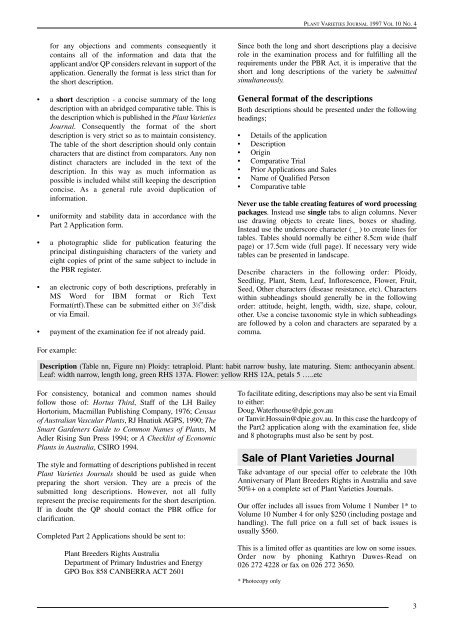62. Volume 10- Number 4 - IP Australia
62. Volume 10- Number 4 - IP Australia
62. Volume 10- Number 4 - IP Australia
You also want an ePaper? Increase the reach of your titles
YUMPU automatically turns print PDFs into web optimized ePapers that Google loves.
PLANT VARIETIES JOURNAL 1997 VOL <strong>10</strong> NO. 4<br />
for any objections and comments consequently it<br />
contains all of the information and data that the<br />
applicant and/or QP considers relevant in support of the<br />
application. Generally the format is less strict than for<br />
the short description.<br />
• a short description - a concise summary of the long<br />
description with an abridged comparative table. This is<br />
the description which is published in the Plant Varieties<br />
Journal. Consequently the format of the short<br />
description is very strict so as to maintain consistency.<br />
The table of the short description should only contain<br />
characters that are distinct from comparators. Any non<br />
distinct characters are included in the text of the<br />
description. In this way as much information as<br />
possible is included whilst still keeping the description<br />
concise. As a general rule avoid duplication of<br />
information.<br />
• uniformity and stability data in accordance with the<br />
Part 2 Application form.<br />
• a photographic slide for publication featuring the<br />
principal distinguishing characters of the variety and<br />
eight copies of print of the same subject to include in<br />
the PBR register.<br />
• an electronic copy of both descriptions, preferably in<br />
MS Word for IBM format or Rich Text<br />
Format(rtf).These can be submitted either on 3 1 ⁄2”disk<br />
or via Email.<br />
• payment of the examination fee if not already paid.<br />
Since both the long and short descriptions play a decisive<br />
role in the examination process and for fulfilling all the<br />
requirements under the PBR Act, it is imperative that the<br />
short and long descriptions of the variety be submitted<br />
simultaneously.<br />
General format of the descriptions<br />
Both descriptions should be presented under the following<br />
headings;<br />
• Details of the application<br />
• Description<br />
• Origin<br />
• Comparative Trial<br />
• Prior Applications and Sales<br />
• Name of Qualified Person<br />
• Comparative table<br />
Never use the table creating features of word processing<br />
packages. Instead use single tabs to align columns. Never<br />
use drawing objects to create lines, boxes or shading.<br />
Instead use the underscore character ( _ ) to create lines for<br />
tables. Tables should normally be either 8.5cm wide (half<br />
page) or 17.5cm wide (full page). If necessary very wide<br />
tables can be presented in landscape.<br />
Describe characters in the following order: Ploidy,<br />
Seedling, Plant, Stem, Leaf, Inflorescence, Flower, Fruit,<br />
Seed, Other characters (disease resistance, etc). Characters<br />
within subheadings should generally be in the following<br />
order: attitude, height, length, width, size, shape, colour,<br />
other. Use a concise taxonomic style in which subheadings<br />
are followed by a colon and characters are separated by a<br />
comma.<br />
For example:<br />
Description (Table nn, Figure nn) Ploidy: tetraploid. Plant: habit narrow bushy, late maturing. Stem: anthocyanin absent.<br />
Leaf: width narrow, length long, green RHS 137A. Flower: yellow RHS 12A, petals 5 …..etc<br />
For consistency, botanical and common names should<br />
follow those of: Hortus Third, Staff of the LH Bailey<br />
Hortorium, Macmillan Publishing Company, 1976; Census<br />
of <strong>Australia</strong>n Vascular Plants, RJ Hnatiuk AGPS, 1990; The<br />
Smart Gardeners Guide to Common Names of Plants, M<br />
Adler Rising Sun Press 1994; or A Checklist of Economic<br />
Plants in <strong>Australia</strong>, CSIRO 1994.<br />
The style and formatting of descriptions published in recent<br />
Plant Varieties Journals should be used as guide when<br />
preparing the short version. They are a precis of the<br />
submitted long descriptions. However, not all fully<br />
represent the precise requirements for the short description.<br />
If in doubt the QP should contact the PBR office for<br />
clarification.<br />
Completed Part 2 Applications should be sent to:<br />
Plant Breeders Rights <strong>Australia</strong><br />
Department of Primary Industries and Energy<br />
GPO Box 858 CANBERRA ACT 2601<br />
To facilitate editing, descriptions may also be sent via Email<br />
to either:<br />
Doug.Waterhouse@dpie.gov.au<br />
or Tanvir.Hossain@dpie.gov.au. In this case the hardcopy of<br />
the Part2 application along with the examination fee, slide<br />
and 8 photographs must also be sent by post.<br />
Sale of Plant Varieties Journal<br />
Take advantage of our special offer to celebrate the <strong>10</strong>th<br />
Anniversary of Plant Breeders Rights in <strong>Australia</strong> and save<br />
50%+ on a complete set of Plant Varieties Journals.<br />
Our offer includes all issues from <strong>Volume</strong> 1 <strong>Number</strong> 1* to<br />
<strong>Volume</strong> <strong>10</strong> <strong>Number</strong> 4 for only $250 (including postage and<br />
handling). The full price on a full set of back issues is<br />
usually $560.<br />
This is a limited offer as quantities are low on some issues.<br />
Order now by phoning Kathryn Dawes-Read on<br />
026 272 4228 or fax on 026 272 3650.<br />
* Photocopy only<br />
3

















